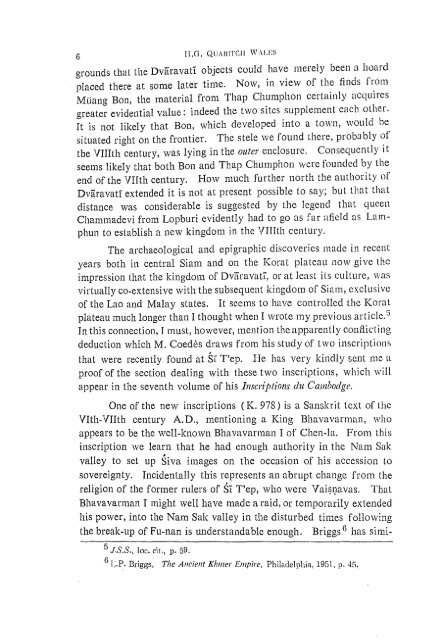The Journal of the Siam Society Vol. LIII, Part 1-2, 1965 - Khamkoo
The Journal of the Siam Society Vol. LIII, Part 1-2, 1965 - Khamkoo
The Journal of the Siam Society Vol. LIII, Part 1-2, 1965 - Khamkoo
Create successful ePaper yourself
Turn your PDF publications into a flip-book with our unique Google optimized e-Paper software.
IT.G. QUAH!TCII<br />
6<br />
VI'.\U:s<br />
grounds that <strong>the</strong> Dvaravati objects could have merely been a hoard<br />
placed <strong>the</strong>re at some later time. Now, in view <strong>of</strong> <strong>the</strong> finds from<br />
Miiang Bon, <strong>the</strong> material from Thap Chumphon certainly acquires<br />
greater evidential value: indeed <strong>the</strong> two sites supplement each o<strong>the</strong>r.<br />
It is not likely that Bon, which developed into a town, would be<br />
situated right on <strong>the</strong> frontier. <strong>The</strong> stele we found <strong>the</strong>re, probably <strong>of</strong><br />
<strong>the</strong> VIIIth century, was lying in <strong>the</strong> outer enclosure. Consequently it<br />
seems likely that both Bon and Thap Chumphon were founded by <strong>the</strong><br />
end <strong>of</strong> <strong>the</strong> VIIth century. How much fur<strong>the</strong>r north <strong>the</strong> authority <strong>of</strong><br />
Dvaravati extended it is not at present possible to say; but that that<br />
distance was considerable is suggested by <strong>the</strong> legend that queen<br />
Chammadevi from Lopburi evidently had to go as far afield as Lamphun<br />
to establish a new kingdom in <strong>the</strong> VIIIth century.<br />
<strong>The</strong> archaeological and epigraphic discoveries made in recent<br />
years both in central <strong>Siam</strong> and on <strong>the</strong> Korat plateau now give <strong>the</strong><br />
impression that <strong>the</strong> kingdom <strong>of</strong> Dvaravati, or at least its culture, was<br />
virtually co-extensive with <strong>the</strong> subsequent kingdom <strong>of</strong> <strong>Siam</strong>, exclusive<br />
<strong>of</strong> <strong>the</strong> Lao and Malay states. It seems to have controlled <strong>the</strong> Korat<br />
plateau much longer than I thought when I wrote my previous article. 5<br />
In this connection, I must, however, mention <strong>the</strong> apparently conflicting<br />
deduction which M. Coedes draws from his study <strong>of</strong> two inscription~<br />
that were recently found at Si T'ep. He has very kindly sent me a<br />
pro<strong>of</strong> <strong>of</strong> <strong>the</strong> section dealing with <strong>the</strong>se two inscriptions, which will<br />
appear in <strong>the</strong> seventh volume <strong>of</strong> his Inscriptions du Cambodge.<br />
One <strong>of</strong> <strong>the</strong> new inscriptions ( K. 978) is a Sanskrit text <strong>of</strong> lhe<br />
Vlth-VIIth century A.D., mentioning a King Bhavavarman, who<br />
appears to be <strong>the</strong> well-known Bhavavarman I <strong>of</strong> Chen-la. From this<br />
inscription we learn that he had enough authority in <strong>the</strong> Nam Sale<br />
valley to set up Siva images on <strong>the</strong> occasion <strong>of</strong> his accession to<br />
sovereignty. Incidentally this represents an abrupt change from <strong>the</strong><br />
religion <strong>of</strong> <strong>the</strong> former rulers <strong>of</strong> Si T'ep, who were Vai$l)avas. That<br />
Bhavavarman I might well have made a raid, or temporarily extended<br />
his power, into <strong>the</strong> Nam Sak valley in <strong>the</strong> disturbed times following<br />
<strong>the</strong> break-up <strong>of</strong> Fu-nan is understandable enough. Briggs 6 has simi-<br />
5 J.S.S., Joe. cit., p. 59.<br />
6<br />
r;.p. Briggs, Tire Ancifllf Kluner Empire, Philadelphia, 1951, p. 4::;,

















